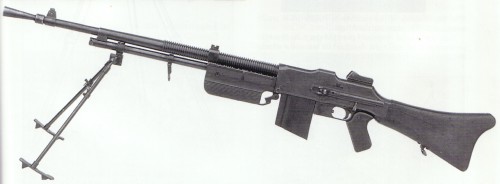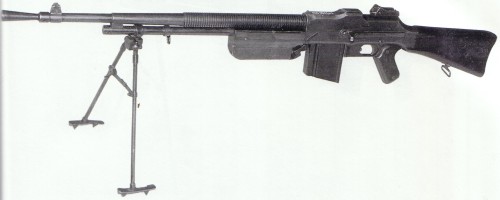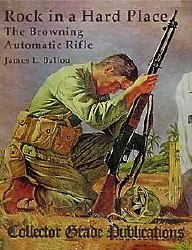 |
Wz.28: The Polish BAR |  |
|
|
|
|
CRUFFLER.COM
presents
HISTORIC
FIREARM OF THE MONTH,
December
2000:
 |
Wz.28: The Polish BAR |  |

Image credit: Ballou, James, Rock in a Hard Place, Collector Grade Publications, Cobourg, Ontario: 2000 Page 417 |
SPECIFICATIONS
Type: Light Machine Gun System of Operation: Gas Caliber: 7.9x57mm Mauser Capacity: 20 round box magazine Sights front: Blade,drift adjustable for windage Sights, rear: Fully adjustable u-notch Length: 45.28" Weight (unloaded): 20.5 lbs Barrel: 24.05" |
The Armistice that ended World War One saw the re-emergence of the Polish state after more than 100 years of domination by powers including Prussia, Russia, Germany, and Austria. The military charged with defending the nascent state found itself equipped with a collection of weapons that was eclectic to say the least. The light machinegun inventory was no exception to this situation. There were Lewis guns, Bergmann MG15na's, Madsens, Chauchats, and Maxims. It was decided that that a new light machinegun would be chosen by the army with which to replace all the disparate and obsolescent types.
(Note: The Polish Army observed a distinction between types of light machineguns, and this distinction can be noted in the nomenclature assigned to the different models. Lekki karabin maszynowy or LKM, literally translates to light machine gun, and refers to a lightened version of a belt fed machinegun. A prime (but not Polish) example of this would be the Browning M1919A6. Alternatively, reczny karabin maszynowy or RKM, which translates to hand held machine gun, refers to magazine fed machine rifles or light machineguns such as the Bren or the BAR. This method of classification based on feed system was maintained until the beginning of World War Two.)
Meanwhile,
back in Warsaw the frantic search for a new light machinegun continued.
. . The Polish Army created a board of officers charged with organizing
a competition to choose a new light support weapon. The board held
the first round of competitions in July, 1924. The entrants included
the Lewis, Madsen, Benèt-Merciè, the Hotchkiss Model
1922, and three versions of the Browning Automatic Rifle (BAR): the
US M1918, the Fabrique Nationale Modèle 1922 (which was actually
made by Colt), and the US M1922 Cavalry Machine Rifle. Despite the
number of well qualified entries, the initial competition concluded with
no clear winner, and the Board declined to accept any of the guns submitted.
Another round of competition was therefore scheduled for January and February
1925. This next round featured more entrants, including the Madsen
wz.24 (NB: The Polish word for model is "Wzor" and is abbreviated "wz."),
the Beardmore-Farquhar wz.24, the French Lewis wz.23, the Chatellerault
wz.24, the Hotchkiss wz.23 - Model 1922, the Italian ALA wz.24, a Swiss
Furrer wz.25, and two commercial BAR's - wz.24, one with a 500mm barrel
and one with a 600mm barrel. The BAR's were actually Colt produced,
inch pattern guns supplied to FN under earlier agreements between the two
companies.
| The competition was overseen by the commandant of the Central Shooting School in Torun, Colonel Tadeusz Felsztyn. Under his watchful eye, the field was narrowed to three entrants: The FN supplied BAR, the Hotchkiss Model 1922, and the French Lewis. Of |

FN Model 1924 Image credit: Ballou, James, Rock in a Hard Place, Collector Grade Publications, Cobourg, Ontario: 2000 Page 410 |

Early Polish Made Wz.28 Image credit: Ballou, James, Rock in a Hard Place, Collector Grade Publications, Cobourg, Ontario: 2000 Page 413 |
As with the other BAR variants, the wz.28 is a gas operated, locked breech air cooled autoloader. As the bullet travels down the barrel, it passes a gas port. A small portion of the propellant gas is tapped off and used to propel the gas piston to the rear. As the gas piston moves rearward, it carries the a slide with it. As the |
Despite FN's industrial prowess, the Belgians soon came to the rather unpleasant realization that manufacturing the BAR was a significantly more difficult and more complex task than making Mauser style bolt action rifles. As a result, the contract experienced delays and the first shipment of 8,500 wz.28's was not delivered until November 1929, and the final 1,500 in February 1930. Initial license production in Poland didn't fare much better. To begin with, the Belgians sent the Poles only part of the necessary production documentation, and the documentation supplied was the original Colt inch measurement drawings. It is likely that this was done because the Belgians themselves either lacked a finalized set of production documents or did not believe that their initial metric conversion documentation was good enough to work from. Indeed, it was later discovered in Poland that the initial deliveries from Belgium were not fully interchangeable, and had to be refitted and rebuilt at the PFK.
The Poles were justifiably angered at this perceived slight. All commercial connections with FN were severed, despite the entire payment having been already made. The Polish design team was withdrawn, and engineers Jurek, Skrzypinski, Przybylkowski, and Wasiliew were assigned to draw up a new set of metric blueprints. These activities were delayed by FN's application for a Polish patent on the improvements which had been proposed by the Polish design team while working in Herstal between 1928 and 1929. Despite these obstacles, and the impediments attendant to the FN contract, domestic production of the wz.28 at the PFK got under way in 1930.
Wz.28 production was to continue,
uninterrupted until Poland fell to the Nazis in 1939. All wz.28's,
regardless of whether they were eventually exported, issued to police or
to border troops, were accepted by the Polish Army, and are marked accordingly.
Production totals for wz.28's accepted by the Polish Army are as follows:
|
|
|
|
|
|
|
|
|
|
|
|
|
|
|
|
|
|
|
|
|
|
|
|
|
|
|
|
|
|
Polish stores of wz.28's included
13,009 in 1934, 17,115 in 1936, and 19,971 in 1938. While production
got underway, the Belgian made guns had been issued to the ninety first-line
infantry and cavalry regiments of the Polish Army. First to receive
the wz.28's were the elite Lancer formations, who turned in their old Maxim
MG08/15's in March 1930's. Issue of a light machinegun to cavalry
units caused its own problems. Mounted Polish BAR men complained
that the wz.28, which was more than twice as heavy as the issue Mauser
rifle, was too bulky to be strapped across the saddle, and thus had to
be carried slung diagonally across the back where it caused spinal injuries
while riding. As a result, a carrying rig was perfected in 1931,
and adopted in 1932, with a total of 462 being ordered. The carrier
consisted of a strengthened action cover fitted with rucksack type double
shoulder straps that centered the gun behind the riders' backs.
| In 1935, an improved variant of the wz.28 was introduced. Second variation wz.28's are all fitted with the distinctive anti-aircraft ring sight base on the barrel, possessed a large diameter front sight guard, a smaller battle-sight notch, a reshaped butt with a prominent "fish-tail" contour, a large flash hider, and a reinforced gas | 
Image credit: Ballou, James, Rock in a Hard Place, Collector Grade Publications, Cobourg, Ontario: 2000 Page 417 |
Further modifications were planned for introduction in 1940, but these were overtaken by events, specifically the Nazi invasion in September 1939. These modifications included a folding buttplate like that found on the US M1918A2 BAR, a reinforced bipod with wider skids and stake holes, a muzzle compensator, and a quick change barrel. These modifications were introduced in the prototype wz.28/38B and the wz.28/38T, which underwent trials in December 1938.
The wz.28 saw considerable action during the 1930's, albeit not in Polish hands. A number of wz.28's, along with Chauchat machine rifles, ammunition, grenades, powder, artillery shells, and a variety of other munitions, were covertly sold to the Spanish Republican government, and used during the Spanish Civil War. An initial shipment of 200 gun was sent on September 9, 1936 through the agency of E. Grimard of Paris, allegedly destined for the Mexican Legation in Paris. This was followed by another 100 guns on October 7, 1936, also through E. Grimard,and also allegedly for the Mexicans. A further 225 wz.28's were shipped on July 31, 1937 through M. Wolf, supposedly destined for the Greek Consulate in Gydania, Estonia.
Wz.28's were also issued to the embryonic armored formations on the basis of one gun per TK-3 or TKS (the TK-3 and TKS were more akin to Bren gun carriers than tanks) as secondary anti-aircraft armament. Due to the financial exigencies of the Great Depression, all units were not re-equipped until the late 1930's.
During the short-lived Polish resistance to the Nazi invasion, the RKM wz.28 proved to be an effective and well-liked weapon. They also served with great effectiveness with resistance organizations and later during the late 1940's civil war against the communist backed regime. However, there was other important users of the wz.28.
It is often said that imitation is
the most sincere form of flattery. If that is the case, then wholesale
adoption must be flattery of the highest sort. Many wz.28's captured
from the Polish Army were used by Nazi forces under the designation lMG28(p)
and later lMG154(p). The lMG154(p) had two variations, the lMG154/1(p)
being the earlier version of the wz.28 and the lMG154/2(p) being the later.
The captured wz.28's were issued to German combat formations for use as
automatic rifles rather than as true light machine guns. They were
later replaced by Gewehr 41's and captured Soviet SVT38 and SVT40's.
Other wz.28's were used by the Soviet forces who occupied the eastern half
of Poland in 1939. In a widely publicized Soviet newsreel, Soviet
troops are shown on parade in Red Square in October 1941, on their way
into battle. Among those taking part are formations made up of Moscow's
workers. They carry former Polish Berthier rifles and wz.28's.
BIBLIOGRAPHY
Ballou, James
L., Rock in a Hard Place: The Browning Automatic Rifle, (Collector
Grade Publications, Cobourg, Ontario: 2000)
Rock in
a Hard Place is available from Collector Grade Publications.
Click on the image to order:
